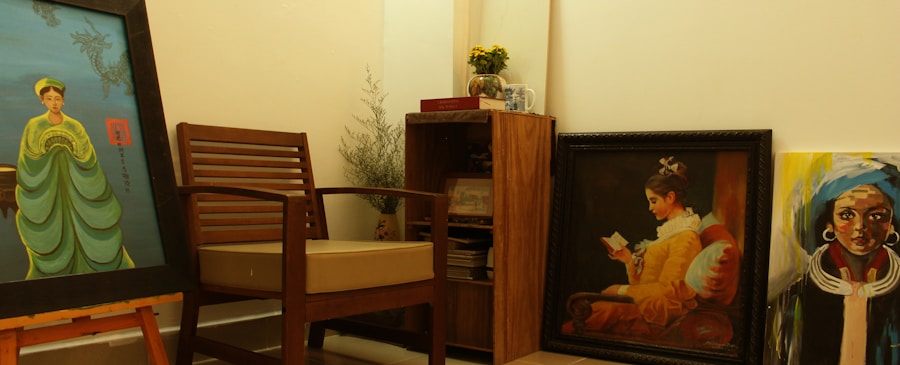Before embarking on any interior design project, it is crucial to have a comprehensive understanding of the space you are working with. This involves not only measuring the dimensions of the room but also considering the natural light, architectural features, and the overall flow of the space. For instance, a room with large windows may benefit from lighter colors and airy fabrics that enhance the brightness, while a smaller, dimly lit room might require strategic use of mirrors and brighter hues to create an illusion of space and light.
Additionally, understanding the purpose of the room is essential. A living room designed for entertaining will have different requirements than a home office or a bedroom. The activities that will take place in the space should dictate the layout and furniture choices.
For example, if the living room is primarily for family gatherings, it should be arranged to facilitate conversation and comfort, perhaps with a circular seating arrangement. Conversely, if it’s a space for quiet reading or relaxation, consider creating nooks with comfortable chairs and good lighting.
Key Takeaways
- Understanding your space is crucial for effective furniture selection and arrangement.
- Choosing the right furniture involves considering both style and functionality.
- Mixing and matching styles can add visual interest and personality to your space.
- Incorporating functional pieces such as storage ottomans or multipurpose tables can maximize space and utility.
- Adding personality with accents like throw pillows, rugs, and artwork can make your space feel unique and inviting.
- Maximizing storage solutions is essential for keeping your space organized and clutter-free.
- Creating a cozy atmosphere can be achieved through the use of soft textiles, warm lighting, and comfortable seating.
- Maintaining and updating your furniture regularly can help prolong its lifespan and keep your space looking fresh and stylish.
Choosing the Right Furniture
Selecting the right furniture is a pivotal step in any interior design endeavor. The furniture should not only fit the aesthetic vision but also serve practical purposes. When choosing pieces, consider their scale in relation to the room.
Oversized furniture can overwhelm a small space, while tiny pieces can get lost in a large room. For example, a plush sectional sofa may be perfect for a spacious living area, providing ample seating for guests, while a sleek loveseat might be more appropriate for a compact apartment. Moreover, functionality should be at the forefront of your decision-making process.
Multi-functional furniture can be a game-changer in maximizing utility without sacrificing style. A coffee table that doubles as storage or an ottoman that can serve as extra seating are excellent examples of how to blend form and function seamlessly. Additionally, consider the materials and durability of the furniture; investing in high-quality pieces can save money in the long run as they withstand wear and tear better than cheaper alternatives.
Mixing and Matching Styles

The art of mixing and matching styles can breathe new life into a space, creating a unique and personalized environment. This approach allows for creativity and expression, enabling homeowners to curate an eclectic mix that reflects their personality. For instance, combining mid-century modern furniture with rustic elements can create an inviting yet sophisticated atmosphere.
A sleek, minimalist coffee table paired with a reclaimed wood sideboard can strike a balance between contemporary and traditional aesthetics. When mixing styles, it is essential to maintain some level of cohesion to avoid a chaotic look. One effective method is to establish a common color palette that ties different elements together.
For example, if you have a vintage armchair in a bold pattern, you might choose throw pillows in complementary colors or patterns that echo its hues. Additionally, consider varying textures; combining smooth leather with soft textiles can add depth and interest to your design while ensuring that the space feels harmonious.
Incorporating Functional Pieces
Incorporating functional pieces into your design not only enhances practicality but also contributes to the overall aesthetic appeal of your space. Functional furniture goes beyond mere utility; it can also serve as a statement piece that elevates the design. For instance, a stylish bookshelf can act as both storage and decor, showcasing books alongside decorative items like plants or art pieces.
Similarly, a dining table with built-in storage can keep dining essentials organized while maintaining an uncluttered look. Another way to integrate functional pieces is through the use of modular furniture. Modular sofas or shelving units allow for flexibility in arrangement and can adapt to changing needs over time.
This adaptability is particularly beneficial in smaller spaces where layouts may need to be reconfigured frequently. By selecting pieces that serve multiple purposes without compromising on style, you can create an environment that is both beautiful and practical.
Adding Personality with Accents
Accents are the finishing touches that infuse personality into your space, transforming it from generic to uniquely yours. These elements can range from artwork and decorative objects to textiles and plants. For example, a vibrant piece of artwork can serve as a focal point in a room, drawing attention and sparking conversation.
Similarly, decorative pillows with bold patterns or textures can add layers of interest to sofas or beds. Incorporating plants is another effective way to add life and character to your space. Not only do they enhance aesthetics with their natural beauty, but they also improve air quality and create a sense of tranquility.
Consider using a variety of plant sizes and types; tall floor plants can fill empty corners while small succulents can adorn shelves or tables. Additionally, personal items such as travel souvenirs or family photographs can be displayed creatively to tell your story and make your space feel more inviting.
Maximizing Storage Solutions

Effective storage solutions are essential for maintaining an organized and clutter-free environment. In many homes, especially those with limited square footage, finding ways to maximize storage without sacrificing style is crucial. Built-in shelving units are an excellent option for utilizing vertical space; they can be customized to fit any room and provide ample storage while serving as a decorative feature.
Another innovative approach is to use furniture that incorporates hidden storage. Beds with drawers underneath or coffee tables with lift-tops can provide additional space for blankets, books, or games without taking up extra room. Wall-mounted shelves can also be used creatively to display items while keeping surfaces clear.
By thinking outside the box and considering unconventional storage solutions, you can create a functional living space that remains visually appealing.
Creating a Cozy Atmosphere
A cozy atmosphere is often characterized by warmth, comfort, and an inviting ambiance. To achieve this effect in your home, consider layering different elements that contribute to a sense of coziness. Textiles play a significant role; soft throws, plush rugs, and comfortable cushions can transform a stark room into a warm retreat.
For instance, layering a chunky knit throw over a sleek sofa adds texture and invites relaxation. Lighting is another critical factor in creating a cozy environment. Soft, warm lighting from lamps or dimmable fixtures can enhance the mood significantly compared to harsh overhead lights.
Incorporating various light sources at different heights—such as floor lamps, table lamps, and wall sconces—can create depth and warmth throughout the space. Additionally, candles or fairy lights can add an enchanting touch that makes evenings at home feel special.
Maintaining and Updating Your Furniture
Maintaining and updating your furniture is essential for preserving its longevity and ensuring that your space remains fresh and inviting over time. Regular cleaning and care are vital; different materials require specific maintenance techniques to keep them looking their best. For example, leather furniture may need conditioning treatments to prevent cracking, while wooden pieces might benefit from polishing to maintain their luster.
Updating your furniture doesn’t always mean replacing it entirely; sometimes simple changes can make a significant impact. Reupholstering chairs or sofas with new fabric can breathe new life into tired pieces without the expense of buying new ones. Additionally, swapping out hardware on cabinets or dressers—such as knobs or handles—can give an entirely new look to existing furniture.
By being proactive about maintenance and open to updates, you can ensure that your home remains stylish and functional for years to come.
If you are looking to upgrade your office space with modern executive desks, be sure to check out the selection at officeinterior.ae. In addition to desks, they also offer a variety of other office furniture options to complete your workspace. Whether you are in need of chairs, storage solutions, or conference room furniture, you can find it all at officeinterior.ae. With their wide range of high-quality products, you can create a stylish and functional office environment that suits your needs.
FAQs
What are interior furnitures?
Interior furnitures are pieces of furniture that are used to decorate and furnish the interior of a space, such as a home, office, or commercial building. They can include items such as sofas, chairs, tables, cabinets, and storage units.
What are the different types of interior furnitures?
There are many different types of interior furnitures, including seating furniture (such as sofas, chairs, and ottomans), tables (such as coffee tables, dining tables, and side tables), storage furniture (such as cabinets, bookshelves, and wardrobes), and decorative furniture (such as mirrors, lamps, and artwork).
What materials are interior furnitures made from?
Interior furnitures can be made from a wide variety of materials, including wood, metal, glass, plastic, fabric, leather, and composite materials. The choice of material often depends on the style and function of the furniture piece.
How do I choose the right interior furnitures for my space?
When choosing interior furnitures for a space, it’s important to consider the style, size, and function of the furniture. It’s also important to consider the overall design and color scheme of the space, as well as the specific needs and preferences of the people who will be using the furniture.
Where can I buy interior furnitures?
Interior furnitures can be purchased from a variety of retailers, including furniture stores, department stores, online retailers, and specialty furniture shops. It’s important to consider factors such as quality, price, and delivery options when choosing where to buy interior furnitures.


